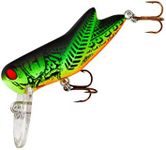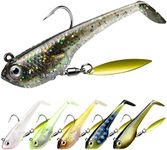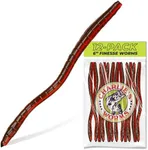Buying Guide for the Best Crappie Lures
Choosing the right crappie lure can significantly enhance your fishing experience and increase your chances of a successful catch. Crappie lures come in various shapes, sizes, and colors, each designed to attract crappie in different conditions and environments. Understanding the key specifications of crappie lures will help you make an informed decision and select the best lure for your fishing needs.Lure TypeLure type refers to the design and function of the lure. Common types include jigs, spinners, crankbaits, and soft plastics. Jigs are versatile and can be used in various water conditions, making them a popular choice. Spinners create vibrations and flashes that attract crappie, while crankbaits mimic the movement of small fish. Soft plastics are flexible and can imitate live bait. Choose a lure type based on the water conditions and the behavior of crappie in your fishing area.
Lure SizeLure size is important because it affects the lure's visibility and appeal to crappie. Smaller lures (1-2 inches) are ideal for clear water and when crappie are feeding on small prey. Medium-sized lures (2-3 inches) are versatile and can be used in various conditions. Larger lures (3 inches and above) are suitable for murky water or when targeting larger crappie. Consider the water clarity and the size of the crappie you are targeting when selecting the lure size.
Lure ColorLure color plays a crucial role in attracting crappie, as it affects the lure's visibility in different water conditions. Bright colors like chartreuse, pink, and white are effective in murky or stained water, while natural colors like silver, black, and brown work well in clear water. Multi-colored lures can also be effective in various conditions. Choose a color that contrasts with the water and matches the local prey to increase your chances of attracting crappie.
Lure ActionLure action refers to the movement and behavior of the lure in the water. Some lures have a subtle, slow action, while others have a more aggressive, fast action. Slow-action lures are ideal for cold water or when crappie are less active, as they mimic the movement of sluggish prey. Fast-action lures are suitable for warm water or when crappie are actively feeding, as they create more vibrations and attract attention. Consider the water temperature and the activity level of crappie when choosing the lure action.
Lure DepthLure depth indicates how deep the lure can go in the water. Some lures are designed to stay near the surface, while others can dive deeper. Surface lures are effective in shallow water or when crappie are feeding near the top. Mid-depth lures are versatile and can be used in various water depths. Deep-diving lures are suitable for fishing in deep water or when crappie are holding near the bottom. Choose a lure depth based on the water depth and the location of crappie in your fishing area.






















